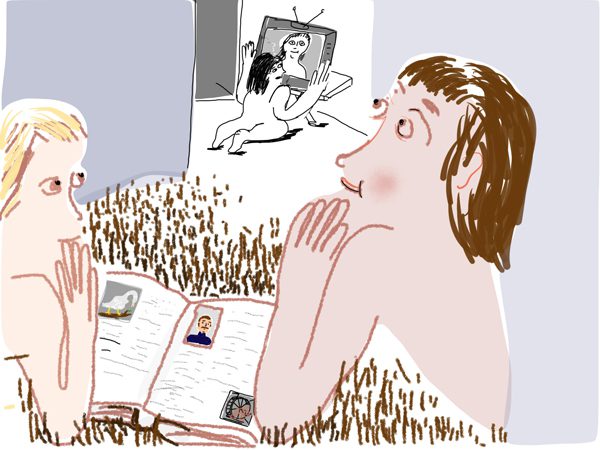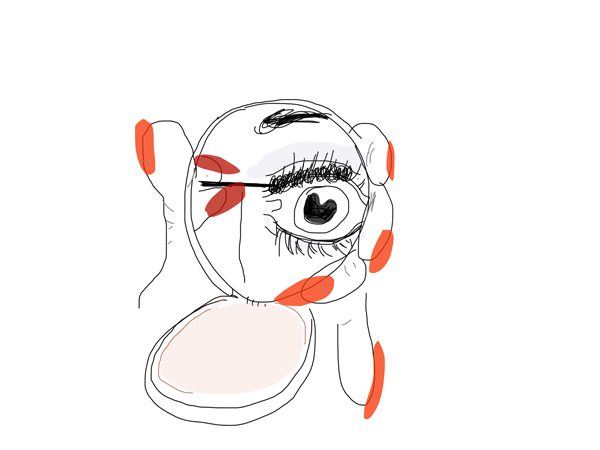There’s evidence that D.H. Lawrence enjoyed an erotic power exchange relationship with his wife, that James Joyce was into scat (among other things), and that Oscar Wilde—well, most of us know what Oscar Wilde liked. These literary geniuses explored radical sexual agency and desire in their work and in their relationships, but little beyond rumors and personal letters exist to tell us what they themselves thought of their turn-ons and the ways in which those dovetailed with their writing. Even if space for such a discourse and community had existed back then, Lawrence, Joyce and Wilde couldn’t freely discuss their sexuality. As it was, they faced censorship and generated scandal wherever they went, and of course Wilde went to prison for his sexual behavior.
Although our world is still intolerant of sexual difference, I want to believe we’re at a point where people can speak openly about the consensual ways we express our erotic selves. And I’m interested in the connections between those private expressions and the larger, more public work we do in the world. This series is meant as a forging of community; a validation of that which gets called sexual deviance; and a proud celebration of the complex, fascinating ways that humans experience desire.
In this ongoing series of short personal essays, writers in all genres—novelists, poets, journalists, and more—explore the intersection between our literary lives and practices and our BDSM and fetishistic lives and practices. In other words, these essays aren’t about writing about non-normative sex: rather, it’s a series about how looking at the world through the lens of an alternative sexual orientation influences the modes and strategies with which one approaches one’s creative work.
If you have questions or comments, or if you’re a writer who would like to contribute, please contact me at kinkwriting@gmail.com.
–Arielle Greenberg, Series Editor
***
The Glory Hole of Nonfiction
Dearest Reader—
It’s Sunday, mid-morning. I write to you from my “desk,” one of those cheap, sturdy blonde pine Ikea tables. My forearms press against a sentence my father years ago painted onto the edge of the tabletop as my fingers hit the keys on a Macbook Pro. I’ll go months working at this desk without noticing these tracings of my father, left here in blue-green paint strokes on the perimeter of this, my writing surface.
 But then, every once in a great while, like I did just a few minutes ago, I look down, rather than out the window, and read what he wrote a decade ago: “Human capacity for colours and shapes is finite.”
But then, every once in a great while, like I did just a few minutes ago, I look down, rather than out the window, and read what he wrote a decade ago: “Human capacity for colours and shapes is finite.”
What in the fuck does that mean? Over time I’ve decided the sentence evidences a struggle to express his belief that humans are painfully limited with respect to what it is we can see, how seeing is impacted by one’s ability to perceive. My father was asserting that colors and shapes—as math, as physics, as science, as energy, as universal magic—exist in hues and forms well beyond what our physical bodies are able to recognize, identify, categorize, and subsequently name. And, I think, Sure. It seems totally logical that there would be hues and shapes that humans can’t perceive.
Then I reconsider. Is it really that human capacity is limited? Or are we limited by what it is we believe we are able, and allow ourselves—are willing—to see?
*
Why, Dearest Reader, am I telling you any of this? Because though my father was, as a visual artist, deeply and desperately attached to color and line, to patterns, shapes and all elements of design, he did not, as far as I could tell, derive pleasure from what it meant to be able to look. He didn’t seem to pay any mind to what it is he could or could not—by virtue of the lighting, perspective, distance, lens, aperture, age, ethnicity, sexual preferences, class, gender, conflict, narrative—see. Another way of thinking about it might be this: he did not regard as pleasurable—as erotic—the very act of looking itself.
I am not saying that he did not engage in the fine art of cruising. He was a gay man who, before his death, discussed with me his strategies for scoping out sexual partners in public spaces, agreed upon sites for this particular way of looking. But his gaze was a way of participating in stories he had already heard, already knew.
For me looking—being able to see—this is my art, my pleasure, my interest. And I enjoy having the frame, the opening, the perspective, the orientation be continually in motion. To be able to fuck with how it is I know I may or may not be viewed, what the story might become. This is where and how I derive pleasure. Through the act of exploring the art of the reveal—how much, when, where, who, why: this is how I seek my bliss.
I am, in other words, a voyeur. In the most colloquial sense, I like to watch. But it’s far more complicated, more nuanced than that. I get off not just by looking, but noticing, and even more than noticing, my erotic desire is connected to the act of taking note. What I am struggling to say is this: My sexuality is writer.
What I mean when I say my sexuality is writer is that my way of writing is informed by my identity as a voyeur. Voyeurism isn’t only about watching, or looking. It’s about exploring the erotic power in how it is you look, and what you can see. As much as where I look is important, how I look is what creates the erotic energy that inspires and informs the way I write. As a voyeur, I watch in a way that is about gathering information, studying the person, the situation. I move through the world conscious of movement, objects, scenes and interactions that attract my attention. Not only because I might write about them later, but because by paying close attention to how I frame my gaze, I am better able to think about which words I’ll choose to offer you on the page.
Whenever I am in an airport, I don’t people-watch in order to make up stories about them as characters, imagining a plot line for their lives. Rather, I scan the room until my eye catches on a detail. A woman—it’s almost always a woman—doing something. And then, I look in and for places—seams, fissures, punctures, holes, openings—that present ways of knowing that push beyond surface description. Maybe she’s feeding her baby Cheerios. As beautiful as she may be, I’ll be most enticed by the way she fingers the little oat loops before pressing them, one at a time, into the child’s mouth, her tension standing in complete opposition to the clear drool that drips easily—brightly—from the child’s mouth.
My kink doesn’t usually look like kink. When it’s done well, when it’s executed with skill and dexterity, voyeurism isn’t showy: it isn’t something for someone else to recognize or notice. The voyeur takes note and mentally records the events, without being clocked for staring. The rush is to become skilled at looking without our own kink ever being seen.
To enact my desire, I don’t require much—actually any—equipment or space. In general, I make little to no noise. I hardly ever end up removing my clothing. No physical contact is required. Though the sentiment and sensation itself is characteristically private, most of these interactions occur in a complete range of public space. I am titillated by the thought of observing without being noticed, but most aroused by watching someone who knows I am watching them, connecting with them across the room, out it the open, sharing an exchange, hidden in plain sight.
But, if you’ve made any assumptions, Sweet Reader, about what it is that pleases me, let me be clear. I can assure you it doesn’t necessarily mean that if you were in this room next to me doing something dirty, that I’d stay just to watch. I might, because I definitely enjoy observing the way a dom might tap and pinch the skin before inserting a needle, the way a sub breathes deeply before being caned. But if the scene is trite and tried, without artistry or authenticity, you can be sure I am not looking. If there’s no way for me to reposition myself to see something more and other than you and your partner are getting from your experience, I have zero interest. If your scene is presented to me with a wide-angle lens, and taps into a pre-determined grand narrative of heteronormative desire, you can be sure that I’ll get up, turn away, and leave.
What do I love best? Watching a woman put on her makeup. However much or little, with whatever speed or deliberation she requires. And my most secret delight? Catching a woman putting on lipstick in in the bathroom. Does she make two tiny arches on her upper lip? One quick broad stroke across the bottom before pulling the lips in and then sliding them together? How, or rather does she, bother to blot?
*
I write literary, creative nonfiction, which means I often write about my own life, what’s happened to me, what I think about those events, how they work in this world. When I write, I approach the re-creation of any particular scene by thinking first about the size of the opening I want you to look through, the distance from which you get to peer through the aperture, the proximity of the subject and/or scene on the other side. Is it a miniscule rip in an otherwise nearly sheer fabric? Is it a tear in a circus tent? A glory hole in a bathroom stall? Is the approach and view one best understood as a peek over a fence? A glance through a rearview mirror? Are the subjects in the scene larger, smaller, farther or closer than it may initially appear?
The looking becomes hottest not only when the one you’re watching permits you to watch, but when the watching itself becomes more than a game, and shifts into an energy exchange. Sometimes women are well aware I am studying them, locating my desire in figuring out how it is I can best admire and watch them. Other times, they have no idea.
In my writing life, I am always writing to, with and for a particular reader—usually a specific real person who has caused a split in the taut membrane of my erotic desires—a space through which I can see, identify, feel my own bliss.
It also is through the actual writing of words on a page that I get off. As I sit here, I think of what it means to word-cum and phrase-fuck; to understand sentence as strokings. And the person for whom I write has everything to do with my choices for the opening, the fabric imagined for the scene, the aperture, and focus of the lens. I write to please myself; I write as I think they might be pleasured as they read.
Let me be clear, too that this idea of sexuality as writer is not, by my estimation, unique or new. I find evidence and descriptions of such a subject position in the writings of Helen Cixous (especially Three Steps on the Ladder of Writing,) and in Roland Barthes’s The Pleasure of the Text. Yet where as Barthes says that it isn’t a specific reader he seeks (cruises). For him it is the cruise itself. For me, it is the intensity of the singular imagined audience of one that provides for me the most erotic pleasure.
This is likely the reason I so fetishize the letter—love letters exchanged between women, to be precise. It is in “lesbian” love letters that I’ve looked for evidence of the notion of sexuality as writer. Scholars have spent way too much time worrying about whether or not Emily Dickinson and Susan Huntington ever fucked, were lesbians. Really, who cares? Whether or not they did, the over-the-top poem-letters make clear that Susan was not simply Emily’s muse. Susan and Emily engaged in an intimate exchange through letters of love that illustrate a love for lettering. And, in my estimation, what Emily loved more than anything was the act of engaging with language, and syntax, to and for and with and through Susan.
Here, then, is also why I’m writing this letter to you, and only you. The you who has been interested to get this far. The you who is hoping, perhaps, I find you interesting enough to, one day observe and write about/to/for you. In service-top style, I’ll do it, because it’s my desire to figure out how to best please you.
This letter—all personal correspondence—is the textual version of one-on-one looking, the genre which in its own way manifests a connection between the open secret that is voyeurism and the private space of the epistolary page. Both letter-writing and voyeurism are driven by the desire for relationship intimacy, a part of an acknowledged back-and-forth exchange that is understood in many ways to be private, yet is always working with and within the thrill of possibility of being read and/or caught.
*
Still don’t quite understand? Let me show you:
 Carolyn and I lay bellies down, side by side on the brown shag carpeting, looking through her family’s newly minted 1976 World Book Encyclopedia set. We’d take turns choosing topics—mine gruesome, hers cute—and then I would read aloud the passages. We would do this kind of thing for hours. Usually we were alone. On this day, her little sister, Maryanne, was watching Romper Room on the ginormous console TV.
Carolyn and I lay bellies down, side by side on the brown shag carpeting, looking through her family’s newly minted 1976 World Book Encyclopedia set. We’d take turns choosing topics—mine gruesome, hers cute—and then I would read aloud the passages. We would do this kind of thing for hours. Usually we were alone. On this day, her little sister, Maryanne, was watching Romper Room on the ginormous console TV.
The end of the show came on, the part where Miss Sally pulls out her Magic Mirror and incants: Romper bomper stomper boo, tell me tell me tell me do, Magic Mirror tell me today, did all my friends have fun at play?
I wasn’t really paying attention. I had seen Miss Sally and her mirror before and while I liked watching the huge lollipop-looking color-wheel swirl on her mirror turn into a see-through white-framed, face-sized hole, I didn’t quite get why I should care that Miss Sally could see me.
But Maryanne suddenly scootched way closer to the television than was allowed, popped to her knees from her cross-legged position and started begging. Pleasepleasepleasepleaseplease! Memememememememe! Miss Sally, SEE ME!
A new and instantaneous flicker-thrill rippled through my seven-year old body.
I didn’t care so much about being seen by Miss Sally and her Magic Mirror. What I cared about was looking at the way it made Maryanne feel. I knew in that moment that what I really desired was a Magic Mirror of my own.
*
So, maybe that’s all I wanted to tell you. This perv now has her own Magic Mirror, which I wield always in the service of my nonfiction prose. My Magic Mirror is the imagined frame through which I choose to explore all which I write. When I use my Magic Mirror, I do so in the erotic space of the writer that I am. When I do, I am sure that human capacity for color and shape, for interest and desire, isn’t—never has been—finite.
Until I see you—hoping you ask me to see/write for you—again,
Ames





